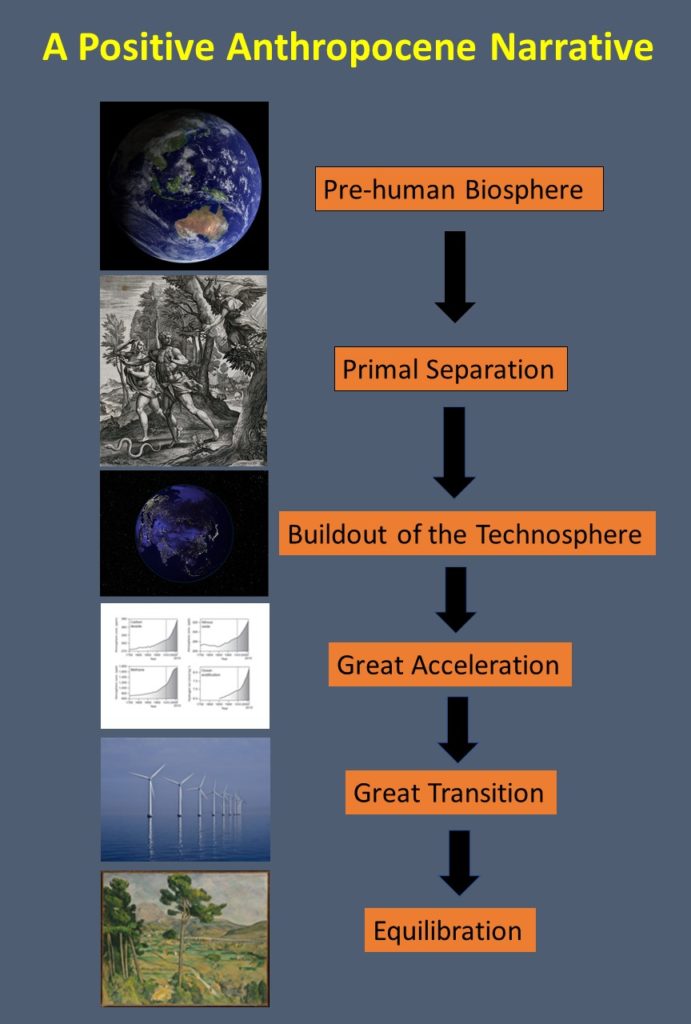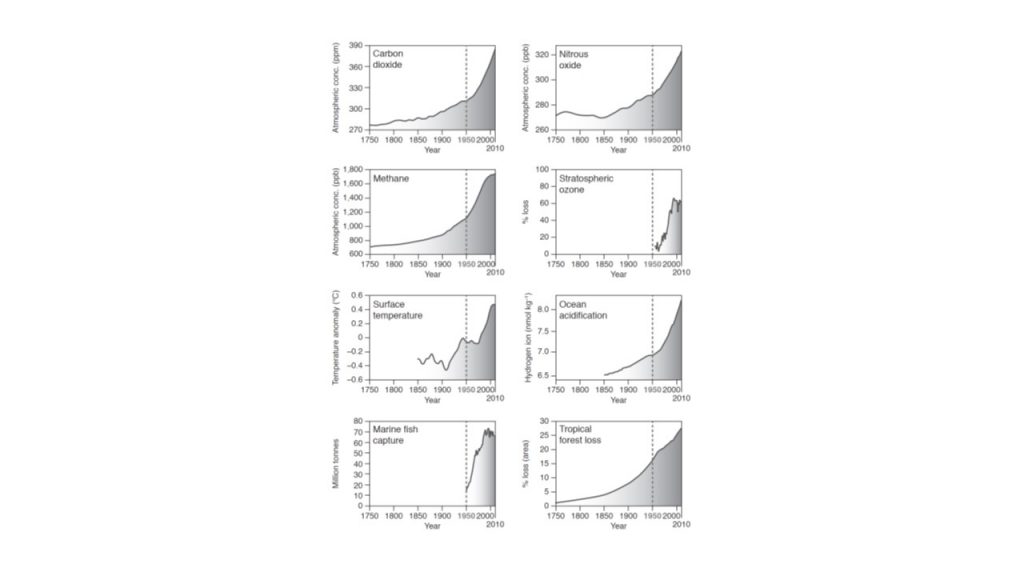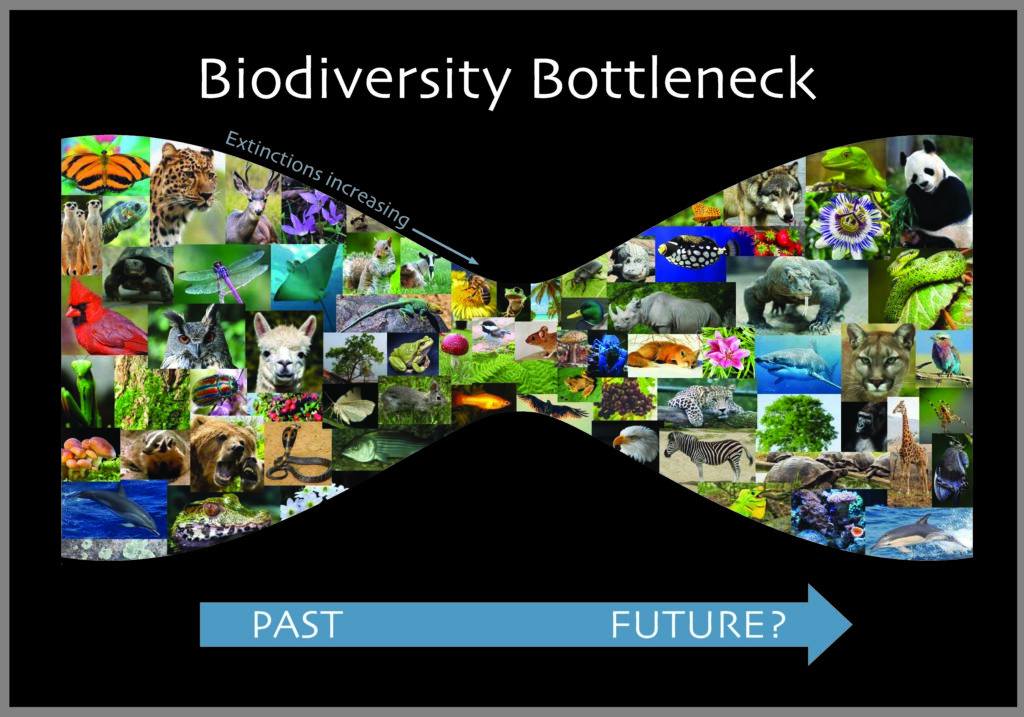David P. Turner / October 11, 2020
Given the gathering storm of global environmental change, our world is in dire need of new ways of thinking. Culture is, in part, the set of beliefs, customs, and knowledge shared by a society; and cultural evolution happens when new ideas or concepts are generated by individuals and spread by way of social learning. If a concept is successfully replicated in the minds of most of the people in a society, it could be said to become part of the culture of that society. Here, I examine the concept of the “Great Transition”, an idea that may help a nascent global society grapple with planetary scale environmental change issues.
The “Great Transition” is a theme employed by authors from a variety of disciplines to characterize how humanity must change in the coming decades.
We can begin with Kenneth Boulding (1910-1993). He was an academic economist who published The Great Transition in 1964. Boulding was an expansive thinker and an early advocate of the spaceship Earth metaphor. Because he was publishing in the middle of the Cold War era, he was concerned about human self-destructive tendencies associated with both the global geopolitical situation and the global environment.
Boulding’s Great Transition called for a gradual augmentation or replacement of “folk knowledge” with scientific knowledge. Both are honed by cultural evolution, i.e. specific beliefs are generated, spread, and retained as part of the cultural heritage within specific social groups. Faith in folk beliefs is based on tradition rather than on an understanding of underlying mechanisms. Folk knowledge sometimes serves mainly to foster group identity (e.g. creation myths that build a shared sense of destiny) but other folk beliefs may have practical significance (e.g. knowledge of medicinal plants).
Various alternative ways of knowing (epistemologies) operate quite differently from folk knowledge. In the scientific epistemology, a consensus model of how the world is structured, and how it functions, is built up over time by way of hypothesis formation and testing. One great virtue of the scientific epistemology is that the consensus model of reality can change based on new observations, ideas, and experiments. Specifically, regarding global environmental change, the scientific community has discovered anthropogenically-driven trends in the global environment and has suggested that they pose a threat to human civilization. As is evident in today’s political battles over climate change, scientific discoveries and science-based mitigation strategies are not always consistent with folk knowledge.
Boulding advocated a more consistent reflexivity in human thinking, i.e. a questioning attitude and an openness to changing beliefs. This thinking strategy was something he wanted all humans to share, even though they might be supporting different ideologies.
Another economist (Mauro Bonaiuti) also wrote a book entitled The Great Transition. For Bonaiuti, a global economic crisis is imminent driven by 1) limits on natural resources such as fossil fuels, and 2) an overshoot in societal complexity.
Bonaiuti focused on a trend in growth of Gross Domestic Product (GDP) for developed countries in recent decades. He found a long-term decline in GDP growth (% per year) across a wide range of developed countries. The driving mechanism was Diminishing Marginal Returns (DMR) on investments associated with reaching the biophysical limits of natural resources (e.g. land available for agricultural expansion). He feared this economic trend portended eventual collapse of capitalism and the ascendancy of autocratic regimes.
Bonaiuti’s Great Transition away from that trajectory was characterized by degrowth − reduction in the importance of market exchange, reduced production and consumption, and transitioning towards forms of property and company ownership that feature local communities, small shareholders, and public institutions.
As an Earth system scientist, I agree with Bonaiuti about the human enterprise on Earth hitting the biophysical limits of the Earth system. Regarding complexity though, I am more sanguine. A transition to global sustainability is likely to require more complexity, especially in the form of a more elaborate set of global governance institutions. The energy costs could be paid by an expanded renewable energy infrastructure (hopefully without the expansion hitting its DMR).
Physicist Paul Raskin developed another version of the “Great Transition”, this one aimed more directly at addressing the problems of biophysical limits. The Tellus Institute, with which he is affiliated, produced a broad program of policy prescriptions designed to foster societal change towards sustainability. One of their prescriptions is a renewable energy revolution (which, not surprisingly is also the subject of a recent book by Lester Brown called The Great Transition). The Tellus Institute published Journey to Earthland in 2016, with Earthland here referring to an emerging “country” that includes all nations on Earth (hence a planetary civilization).
For Raskin, the key factor that could unify humanity is the systemic environmental crises that are rapidly engulfing the world (e.g. climate change). People will be forced to work together to address these crises. He sees the needed change as a bottom-up driven process, i.e. a “global citizens movement” with strong participation of civil society.
Considering this convergence by earlier authors on the theme of transition, I adopted the “Great Transition” label for a phase in what I call A Positive Narrative for the Anthropocene. From an Earth system science perspective on the Earth’s history, I developed this six-phase story of humanity’s relationship to the rest of the Earth system. The Anthropocene Epoch alludes to the recognition by geoscientists, social scientists, and humanities scholars that humanity (by way of the technosphere) has become the equivalent of a geologic force. My Great Transition phase comes between a Great Acceleration phase (1945 – 2020) and an idealized future of global sustainability.
An essential aspect of my Great Transition usage is that a new social entity is born – a collective humanity working together to manage (or at least avoid wrecking) the Earth system as we know it. The coalescence of the United Nations − and its successes such as the Montreal Protocol − hints at the possibilities.
The great inequality in wealth at all scales, the differential responsibility for causing the current global environmental problems, and the differences among people regarding their vulnerability to anthropogenic environmental change, makes it fair enough to question whether there even can be a global “we”. However, a majority of humans (5.2 billion out of 7.7 billion) now have a cell phone. Almost all contemporary humans aspire to use energy and natural resources to achieve and maintain a reasonably high standard of living. That striving is, of course, causing global environmental change. So, indeed, there is a global “we”. And a transition to global sustainability is impossible unless most people on the planet acknowledge membership in that “we”.
The Great Transition must be a global scale phenomenon. However, the actual changes required will be made across a range of scales from individuals (decisions as consumers and voters), to nation-states (e.g. subsidies for renewable energy), to global (e.g. resolutions of the United Nations). Let’s consider several of the important dimensions of the Great Transition.
The Biophysical Dimension
Earth system scientists have identified a set of nine planetary boundaries (e.g. the atmospheric CO2 concentration), and the Great Transition will mean regulating human impacts on the environment enough to stay within those boundaries. At present, the quantitative estimates for those boundaries have significant uncertainties and a robust commitment to continued research is needed. The research will include continued improvement in our capability to monitor and model the Earth system. Model simulations are needed to evaluate the consequences of overshooting the planetary boundaries, as well as possible mitigation strategies (e.g. a carbon tax) that could prevent the overshoot.
The Technological Dimension
The technological dimension of the Great Transition is concerned with discovering and implementing the changes to the technosphere that are needed to achieve global sustainability. As noted, a key requirement will be a new renewable energy infrastructure. Pervasive advances are also needed in transportation technology, life cycle analysis, and in closed loop manufacturing. Technological fixes must be carefully scaled up since unintended impacts may emerge in the process. The field of Science and Technology Studies is beginning to systematically address the relevant issues. I have previously characterized the product of integrating the technosphere and biosphere as the sustainable technobiosphere (Figure 1).

The Psychological Dimension
We all have a personal identity. It begins with the self-awareness that we grow into during childhood; and it evolves over the course of our life. We typically identify ourselves as members of various groups and there is often a psychological tension within a human being between independence and group membership.
These groups may include family, ethic group, professional group, and religious affiliation, as well as citizenship in a city, a state, and a nation. Membership in a group is recognized as conveying rights and responsibilities.
As noted, an essential feature of the Great Transition will be that individuals augment their multiple existing group memberships with membership in new groups focused on addressing human-induced environmental change.
The Education Dimension
One of humanity’s most important evolved traits is the capacity to transfer knowledge by way of social learning. Language is a tool for efficient communication of information horizontally (within a generation) and vertically (across generations). The Great Transition will require a global society with citizens who understand enough Earth system science to appreciate the need for humanity to manage its impact on the biosphere and the rest of the Earth system. They must generally be literate, so as to assimilate basic information about what is going on in the world, and to some degree be scientifically literate so they can understand the underlying mechanisms that explain what is going on.
The Geopolitical Dimension
Since the Treaty of Westphalia in 1648, what happens within national borders is in principle largely left to the inhabitants of the nation. Nations have subsequently become protective of their national sovereignty.
Issues of global environmental change now disrupt and challenge that principle. National emissions of greenhouse gases sum up to a major global scale impact on the environment. National sovereignty is thus not sacrosanct; nations must cooperate, or they will all suffer. The current global wave of nationalism, especially the push back against commitments to international negotiations and agreements, is inhibiting movement towards a Great Transition. A significant step forward would be formation of a new global environmental governance institution, such as the proposed World Environment Organization.
The Great Transition concept has thus far spread rather thinly across humanity. But as a global society forms in response to global environmental change, it should become foundational.















